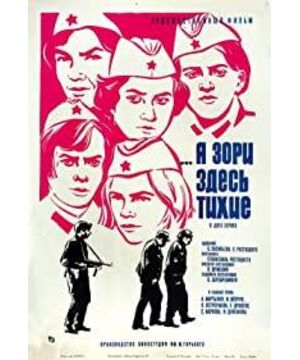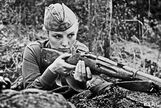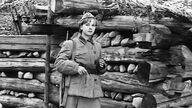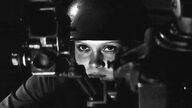The article was first published on the public account [Little Director], please indicate the source for reprinting.
5. Excellent audio-visual language
1) Viewpoint
It can be said that there is only one content expressed in "The Dawn is Quiet": the cruelty of war; the theme reflected is only one point: anti-war. The full connotation of such a story theme itself has already given birth to a strong appeal to the emotions of the audience and readers, and the feature of the film as a medium that distinguishes it from other media is precisely the audio-visual perception it brings to the audience. Physiological and psychological stimulation and impact are the most direct and specific causes of emotional reactions. Therefore, after fully utilizing all audio-visual means, the film has produced an artistic charm that is far incomparable with the abstract text medium on this heavy theme.
A. texture
Texture is the most basic information to record figurative, soft fur cannot be photographed like a hard felt. After the warrant officer had distracted the enemy, he lay down beside the swamp and woke up with the landlady in his mind, a colorful passage, the milky white color when the camera finally pushed towards the milk being poured from the milk jug The texture of the milk is in stark contrast to the grim black-and-white footage that returns to the reality of war, and it is also one of the forms of the contrast between peaceful life and war that is repeated in the film. The connection between these two shots reflects the theme. In the colorful passages of peaceful life, the contrast between the brilliant colors of the fiery red forest in autumn and the severe tones of the black and white forest in the time and space of war has also become the theme of the whole film, which belongs to the message conveyed by the texture. The means of further expressing meaning on the basis of texture is the viewpoint, which is the attitude, which is of course the attitude of the creator or the attitude expressed by the viewpoint of the characters. For example, the five female warriors in the film are more beautiful in their respective colorful memory passages, which is the creator's attitude towards war and peace.
Above, we've talked about an upbeat mood in the first half of the film, but are we just seeing laughter here? Do you not feel the cruelty of war at all? The contrast here is between the past war time and space and the girls' memories and reverie worlds. When this super-narrative time and space of the past as a memory in the film abandons the method of objectively narrating the lives of the five girls in the novel, it also naturally abandons the description in the original novel about the life of each girl. The inherent hardships, blandness, and injustice are replaced by subjective memories or reverie from a personal point of view, showing the happiest and most romantic moment in every girl's life-the moment of love, these two The contrast between the fates of time and space is shocking. At the same time, because the film uses a decisive visual factor - color, the meaning of this contrast is even stronger.
In order to reflect the ruthlessness of war, the past war time and space are completely expressed in black and white, while the other three time and space are displayed in expressive and lyrical colors, each time and space has a different main color. The peaceful life after the war is the most splendid color in these three time and space. At the same time, it also has a fiery red main color-fiery red maple leaves, the girl in a fiery red shirt, everything is so warm, so colorful and so rich. , the young people on the picnic were filled with a high, excited mood. The super-narrative time and space with pure white as the main color brought by the memories and reverie of the girls can be said to be the most wonderful passage in the whole film, especially in Lida's memory, white is a kind of surrealism. use. Everything is pure white -- the environment in which the girl lives, the girl herself, and the girl's dream. In this pure, dreamlike world, every girl is the most beautiful and charming, and even the ugliest Lisa and Galia become beauties. So every time, when we are suddenly pulled back to the wartime state from our memories, the contrast between the beautiful girl in the gentle village and the rough face eroded by the war in front of us reinforces the theme of the story again. The warrant officer's memories and imagination of the girls are based on the sassy and heroic appearance of the five girls in military uniforms, mainly in military green.
B. The audiovisual image of the character
We can take the example of warrior Lisa more specifically. In general, Lisa was not a very beautiful girl. In comparison, she looks more beautiful in her recollection shots, with long braids and red cheeks, especially when she wears a headscarf. But immediately after this close-up of this colorful flashback, cut back to the time and space of war in black and white, the close-up of her beside the wooden boat on the lake, with the short hair, pale face, broad face silhouette, makes her completely transformed It looks a bit ugly even. The connection of these two shots will cause a very strong reaction from the audience, "Ah, how can it be so ugly!" Here, the two shots of Lisa returning from memory to reality are not smooth editing methods, compared with the previous article. The cuckoo's call is a smooth editing technique. Since there is smoothness, of course there is not smoothness. This is a dialectical relationship. Blindly pursuing fluency without disregarding the requirements of content is at least a manifestation of poor audio-visual language knowledge and skills. But when she replied to the warrant officer, "This is a male duck calling a female duck", the camera chose her most beautiful profile, and the main light hit the back side, giving a sweet feeling. This is the kind of silent love that the writer is alluding to to the lieutenant. Lisa has never really confessed to the lieutenant, and this kind of feeling of hers is alluded to by the creator's point of view to the audience. There are as many as four or five such scenes. Finally, when the dead Lisa came to the Warrant Officer's mind, the soft light cast her as a pure maiden, although her cheeks were pale, her lips were bloodless, and she wore the short hair she had left behind when she joined the army. These different images of Lisa all reflect the creator's attitude towards the character of Lisa in different situations, and we can clearly see that these images do not rely more on the performance of the actors (records on the screen). image), but rather the photographer’s use of light and angles and the artist’s makeup. This also explains the great difference between film performance and stage performance. In film and television, photography, art, recording, and editing all participate in the performance of actors. In the creation of Chinese film and television, the situation is quite the opposite. Therefore, when analyzing performances in foreign films, attention should be paid to the degree of participation of other factors. Surprisingly, some of our young photographers don't know that his camera should be actively involved in the actor's performance, they are simply recording the actor's performance. That's okay, what's even scarier is that they're simply recording "that actor who talks is talking".
C. Visual themes
In the section of the bathhouse, the film directly shows the beautiful naked bodies of these girls, as described in the novel, especially Renia's body. Ranka, you are such a mermaid! ", "Ranka, your skin is transparent!" ", "Ranka, I can make a statue of you!" ", "Ranka, you don't have to wear a bra at all! ", "Oops, Ranka, I should send you to the exhibition!" In a glass cover, standing on black velvet..." And at the end of the film, it is this beautiful Renia whose body is gouged out by German fascist machine guns. Obviously, this performance fully reflects the film But the fake Taoist gentlemen of feudalism can't understand it. They will scold the street when they see it. Of course, it is only done in public places for people to see, when no one......
2) The relationship between the five female warriors and the warrant officer - the visual character
Director Roztowski's visual handling of the characters is quite delicate. He not only uses the characters' dialogues, but also depicts the characters and their relationships through many subtle visual factors, which are often esoteric, making people feel very natural and believable.
For example, the warrant officer and Lida, Sonia, and Renia had respectively watched Deko in the crevices of the stone. The audience with strong narration ability will find and remember that Lida and the warrant officer kept a distance when they appeared between the two stones, and they respected each other from beginning to end. And when Sonisonia was ordered to come, the two squeezed closer among the stones in order to look for Deko. When Sonia stuck her head higher, the warrant officer pushed her head down slightly roughly. Although the warrant officer admired her knowledge very much, he always thought she was a nerd and had no military knowledge, so he always seemed very impatient with her clumsy movements. By contrast, when the warrant officer and five female warriors pretended to be lumberjacks cutting wood, he ordered Renia to go with him to spy on the enemy. After the two rushed behind a stone crevice, Renia casually pressed her cheek against the warrant officer's right arm and looked forward, while the warrant officer was obsessed with observing the enemy's situation, seemingly unaware. From the relationship between the three female warriors and the warrant officer, we can feel the romantic character of Renia prominently.
Of course, the characterization of Renya's character is not limited to this. To stress again, film and television works first express everything through visible and audible means, including the relationship between characters. The audience must have something to see and something to hear. It's a stage play or a radio play that shows characters based on dialogue alone. Characters must have audio-visual characteristics, including character traits. The Soviet and Hollywood productions are very clear about this. Take Renya in "The Dawns Here Are Quiet" as an example. Not only do we know from her memory passages that she is a bold and romantic girl, but also in the film. There are a series of details to express her character, such as she always likes to show her blond hair and her shapely, slender figure (bath section); her military coat collar is often left unbuttoned ( Even in the flashbacks in color, and that detail was designed by the artist); unlike the other girls, when she sat down beside the warrant officer, she was next to him (see Analysis below); in addition, she also violated military regulations by wearing silk underwear. So in the last battle, when Lida was injured in the abdomen, the warrant officer ordered her to find a piece of underwear to use as a bandage, but what she brought was a silk undergarment that did not absorb water, the warrant officer took it and threw it away, standing Get up and find a bandage substitute yourself. This detail maintains a consistent portrayal of Renia's character. The camera can only capture the appearance, so the creator must find the accurate appearance, so that the audience can see the inner things under the surface from the appearance. The relationship between the warrant officer and Lisa is also very delicate. The things that happened at the station are so obvious that they don't need to be repeated. It is worth noting that in the sniper position, when the warrant officer inspected Lisa's lookout point, while the two were chatting, we found that Lisa quietly lowered her eyes and glanced at her left sleeve, and then used a kind of cover up. The action of tucking in the cuff of the white military shirt that was exposed outside the left cuff. At the same time, her eyes were fixed on the warrant officer, as if to prevent the warrant officer from seeing her movements. A girl in a military uniform has nothing to dress up, but in front of her beloved warrant officer, she still can't help but want to dress herself at least neatly. This kind of girl's mood aroused people's deep thinking about the war. As for the youngest Galia, the warrant officer saw her as a little girl. In the reserve position, when the warrant officer fed her the "potion", he didn't take any precautions at all. He patted her back lightly with his hands, covered her with his military coat, and stuffed her shoulders tightly.
In this way, we can see the different relationships between the five female warriors and the warrant officer, and because this relationship is expressed through visual actions, without the aid of dialogue, once captured by the audience, it will be memorable.
3) Lens accumulation
Because what appears on the screen is not the performance of a real person like on the stage, but the recording and restoration of light and sound waves performed by a real person, it is a sound image, an illusion of light, shadow and sound. to study them from a linguistic point of view.
First of all, it should be clear that the role of camera accumulation is not limited to the performance of characters, but in "The Dawn is Quiet", it is most clearly manifested in the introduction of the character of the lieutenant. On the position, we can see from his actions that he is a very capable soldier with rich combat experience. At the same time, we also feel more and more that he has a good impression of Lisa, and is the selection standard of farmers. A working rural girl. He had great respect for Sonia because she could read poetry. He also had some feudal thoughts, and when Renia sat down to meet him, he immediately avoided it. Although he was meticulous in his requirements for these female warriors, he always believed that fighting was a man's business, and women should not fight, so when Sonia was the first to be killed by German devils, he was particularly distressed. Although he initially gave the impression of a dogmatic adherence to military doctrine, in battle, when Galia showed cowardice, he restrained the other two female fighters from criticizing her and instead managed to slowly educate her. She, keep her by his side, protect her, even if doing so increases his own danger. He was very forgiving of her, and he later told Lida and Renya that Galia had died heroically in a confrontation with the enemy. All of this is accumulated in the whole film, through the accumulation of the lens, only the scales and claws let the audience slowly observe the accumulation, and finally draw their own conclusions, and because of this, the image of the warrant officer has become a life-like image. The same flesh-and-blood characters, rather than labels representing a certain concept. The figurative record and the flexible and free space-time relationship make the accumulation of shots an extremely powerful means of expression in film and television.
There is a saying that, according to the appreciation habits of our nation, the identity, status, name and past of the characters should be clearly explained at the beginning of a narrative work. Up to now, some movie playwrights are still following this rule consciously or unintentionally, for fear that the audience will not understand or understand. "That was his aunt's house. His uncle's surname was Wang. After his father died, he went back to his aunt's house every summer vacation. He didn't pass the university entrance exam this year, and he was in a bad mood, so he went again. It's pitiful." No, there are two more words for this kind of dialogue, ten minutes after the opening, the audience can go home, once and for all. In contrast, the introduction to the character of the lieutenant in "The Dawns Here Are Quiet" is worthy of reference by our playwrights, and it uses the feature of lens accumulation.
Initially, we only knew his name and rank, which seemed inevitable in the military. As for why this warrant officer did not go to the front during the Great Patriotic War, but stayed in a small remote village, we have no idea. All we know is that the artillery is under his control, and we see him inspecting the warehouse, which seems to be his job. After the arrival of the female anti-aircraft artillery, in a conflict between him and the platoon leader Kiryanova, the landlady was very dissatisfied with the platoon leader's sentence "You are hiding here, can you still command?", so she said that he had participated in the battle. (What kind of battle is unknown), he has won medals, was injured, and there are still fragments of shrapnel on his body that have not been taken out yet. Later, after shooting down the enemy plane, in a conversation between the warrant officer and the major, we learn that he dropped out of school when his father was crushed to death by a bear when he was in fourth grade, so he was more culturally than these female anti-aircraft gunners. Six years behind. As for what he did after he dropped out of school, that is what we know from their nagging when the landlady and another village woman were preparing for him before the team set off: he is the eldest son, after the death of his father It's all up to him to support the family, so he's learned to do everything. No one knew his age, the landlady said, and the girls called him old man.
In the scene where the landlady and the platoon leader are drinking tea, through the landlady's mouth, we know that he participated in the Soviet-Finnish war, his wife got into a relationship with a veterinarian in the regiment, and later took his son through the court. return. When the landlady talked about this, the creator arranged for the warrant officer to come into the house, interrupting their conversation. The landlady only had time to quietly add: "It's delivered to his mother." As for what happened to his son? The arrangement of the scene does not even induce any curiosity about the son's condition.
Interestingly, after this last sentence, after forty-nine minutes and thirty seconds of screen time, in the first sniper position, when Renya and Lida teased him if he had a wife and children , we learned that he once had a son, but "mother didn't take good care of it". We can't help but admire the director's composure, and he has compressed a few sentences from the original. The original words were "Children? ... Had a young son. Died. Just before the war broke out."
On the ground, we know from the warrant officer's conversation with Lisa that he, though not a native, has fought in the area in the past. Warrant Officer's
View more about The Dawns Here Are Quiet reviews






